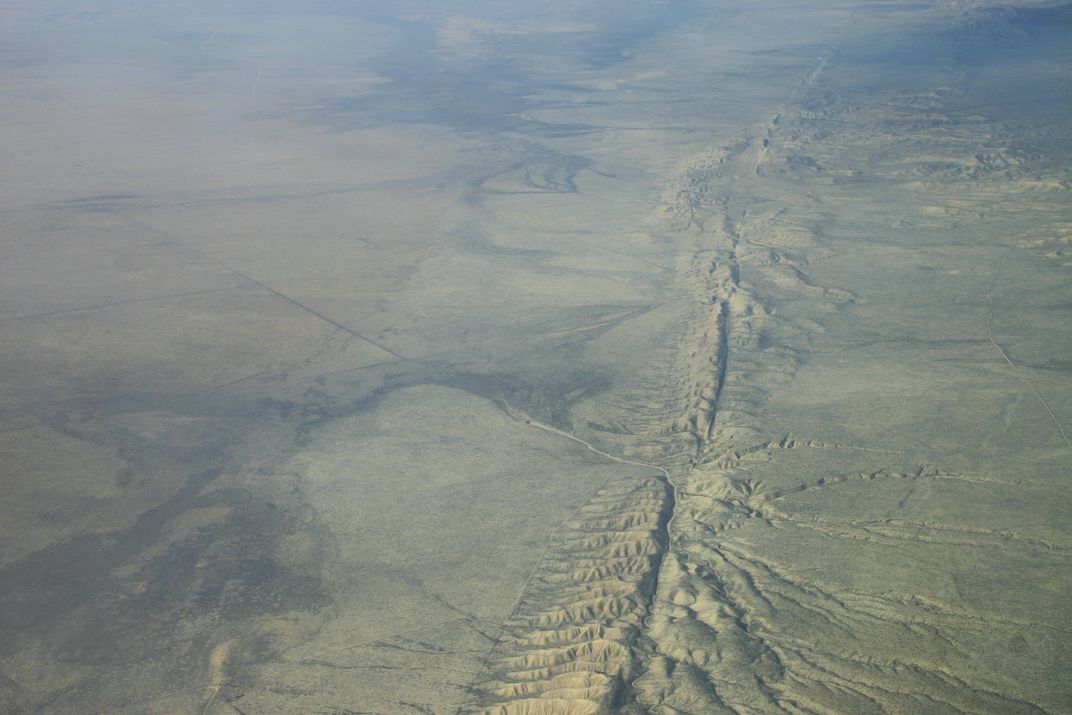Pulling Water Out of the Ground May Lead to Quakes on the San Andreas Fault
Ground movements linked to water extraction may change stresses on the fault famously responsible for California earthquakes
/https://tf-cmsv2-smithsonianmag-media.s3.amazonaws.com/filer/fb/66/fb66556a-4caf-4d2e-889a-1308e647f8f2/farmfield.jpg)
Earthquakes happen every day as the world’s tectonic plates slip, slide, crash and spread. Most are small or happen far away from people. And though scientists have named the faults where most of this action happens, people rarely pay attention unless a major earthquake occurs. One fault, however, is a household name in the United States—the San Andreas fault. It’s the main fault running north-south through western California and was responsible for the great San Francisco quake of 1906, among others.
This fault is a huge worry now because of warnings that the “Big One”—an earthquake of magnitude 6.7 or greater—is overdue. Such a large quake could cause vast destruction in some of the nation’s most populous cities, such as Los Angeles.
Now new findings indicate that water being drawn out of the large aquifer that sits beneath California’s San Joaquin Valley—located in the center of the state—is changing stresses on the San Andreas fault. Scientists aren’t saying that removing water will cause the Big One anytime soon, but they do note that groundwater depletion could be responsible for some of the changes seen in the frequency of small earthquakes in the region. So report Colin B. Amos of Western Washington University in Bellingham and colleagues today in Nature.

The researchers analyzed data from global positioning system stations located across a wide swath of California and Nevada. The instruments are so precise that they can detect changes in movement of the land of less than a millimeter per year.
Those measurements showed that the region that surrounds the San Joaquin Valley is rising by about one to three millimeters per year. That movement is how the earth is compensating for subsidence in the valley itself. The subsidence is occurring because of the removal of water from the aquifer beneath. About 160 cubic kilometers (42 trillion gallons) of water have been removed over the last 150 years. Much of that has gone to irrigate the thousands of acres of farm fields that feed much of the United States.
The uplift in this area isn’t much, but it’s enough to “increase the sliding on the San Andreas fault system” by changing the loads burdening the fault, notes Paul Lundgren, of the California Institute of Technology in Pasadena, in an accompanying News & Views article. “Over the long-term (a 100-year timescale), the unloading generated by constant water extraction…enhances the accumulation of stress between the occurrence of large earthquakes, bringing faults such as the San Andreas closer to failure.”
The study’s results “suggest that human activity may give rise to a gradual increase in the rate of earthquake occurrence, as suggested by earthquake catalogues in central California,” Amos and colleagues write.
This is not the first time that scientists have linked groundwater extraction to earthquakes. In 2012, for instance, researchers reported that the unusually shallow magnitude-5.1 earthquake in Lorca, Spain, in 2011 had been triggered by the removal of water from the ground. And geologists have known for some time that the injection of fluid into the ground—such as for the disposal of fracking wastewater—can trigger quakes.
But what’s worrying here is that the need for California’s groundwater is only going to increase. The population is growing. “Future scenarios for groundwater in California suggest increasing demand for agricultural, urban and environmental use,” Amos and colleagues note. Place that the context of climate change, which “will probably exacerbate the stress on this resource through altered precipitation patterns, more frequent droughts, earlier snowmelt, larger floods and increasing temperatures and evapotranspiration,” they write.
California is already getting a taste of that future—the state is stuck in a severe drought. This year’s snowpack is much smaller than usual. Communities are searching all over for water. Turning to groundwater makes sense, but it appears that the consequences of such an action could be far greater than what we might expect.
/https://tf-cmsv2-smithsonianmag-media.s3.amazonaws.com/accounts/headshot/Sarah-Zielinski-240.jpg)
/https://tf-cmsv2-smithsonianmag-media.s3.amazonaws.com/accounts/headshot/Sarah-Zielinski-240.jpg)